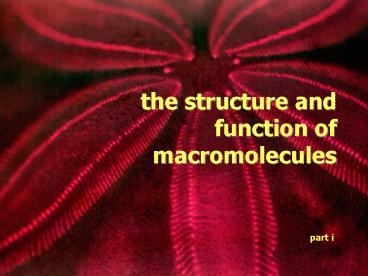the structure and function of macromolecules - PowerPoint PPT Presentation
1 / 56
Title:
the structure and function of macromolecules
Description:
monomer = monosaccharide. polymer = polysaccharide ... glucose is the most common monosaccharide. ii. carbohydrates. disaccharides are made up of two monosaccharides ... – PowerPoint PPT presentation
Number of Views:84
Avg rating:3.0/5.0
Title: the structure and function of macromolecules
1
the structure and function of macromolecules
part i
2
macromolecules
- carbohydrates lipids proteins nucleic
acids
3
polymers
- carbohydrates lipids proteins nucleic
acids
4
what is a polymer?poly many, meris part
- a chain-like molecule made up of repeating parts
- each link in the chain is called a monomer
5
A dehydration reaction removes a water molecule,
forming a new bond
A hydrolysis reaction adds a water molecule,
breaking a bond
6
i. lipids
- are not polymers
- have little to no affinity for water
- three most biologically important kinds are
fats, phospholipids, and steroids
7
i. lipids fats
- energy storage
- cushion
- insulation
8
i. lipids fats
9
i. lipids fats
ester linkage
- composed of 1 glycerol and 3 fatty acids
- also called triglycerides
glycerol fatty acid chain
fat molecule
10
i. lipids fats
11
i. lipids fats
At room temperature, the molecules of a saturated
fat are packed closely, forming a solid.
At room temperature, the molecules of an
unsaturated fat cannot pack together closely
enough to solidify (kinks).
12
i. lipids phospholipids
- 1 glycerol, 2 fatty acids, and a phosphate group
13
i. lipids steroids
- carbon skeleton consists of 4 rings
14
i. lipids steroids
15
i. lipids steroids
- corticosteroids
- sex steroids
- anabolic steroids
16
ii. carbohydrates
- used as cellular fuel
- used for structure and support
- monomer monosaccharide
- polymer polysaccharide
- monosaccharides are linked by glycosidic
linkages.
17
ii. carbohydrates
- monosaccharides (simple sugars)
- fuel for cellular processes
- synthesis of amino acids and fatty acids
glucose is the most common monosaccharide
18
ii. carbohydrates
disaccharides are made up of two monosaccharides
19
what kind of reaction creates disaccharides from
monosaccharides?
- hydrolysis reaction
- covalent reaction
- dehydration reaction
20
what kind of reaction creates disaccharides from
monosaccharides?
- C) dehydration reaction
21
after you drink a class of milk, how does your
body digest lactose (glucose galactose)?
- hydrolysis reactions
- covalent reactions
- dehydration reactions
22
after you drink a class of milk, how does your
body digest lactose (glucose galactose)?
- hydrolysis reactions
23
ii. carbohydrates
- polysaccharides
- energy storage
24
II. carbohydrates
- polysaccharides
- building material for structure
25
II. carbohydrates
- polysaccharides
- building material for structure
26
discussion question
- one gram of fat stores twice as much energy as
one gram of carboyhydrates. - why do animals primarily use fats to store energy
instead of polysaccharides like plants do?
27
iii. proteins
amino acids
polypeptide
protein
28
iii. proteins
- function depends on conformation
- support
- transport
- coordination of activities
- response to stimuli
- movement
- protection
29
amino acids monomers of proteins
30
polypeptidesamino acids connected by peptide
bonds
31
iii. proteins
primary structure amino acids
beads polypeptide necklace
32
iii. proteins
secondary structure results from interactions
between carboxyl and amino groups
33
iii. proteins
tertiary structure results from interactions
between side chains (R-groups)
34
iii. proteins
- quaternary structure
- peptides yarn
- protein sweater
35
iv. nucleic acids
nucleotides
nucleic acid/polynucleotide
two kinds DNA and RNA
36
iv. nucleic acids
37
iv. nucleic acids
nucleotides
nucleic acid/polynucleotide
RNA DNA
38
(No Transcript)
39
Check yourself
- Which of the 4 macromolecules is not composed of
polymers? - What is the difference between a polypeptide and
a protein? - Which type of macromolecule conveys information
to the cell?
40
Check yourself
- Which of the 4 macromolecules is not composed of
polymers?
lipids
41
Check yourself
- What is the difference between a polypeptide and
a protein?
A polypeptide is a string of amino acids while a
protein consists of more than one polypeptide.
42
Check yourself
- Which type of macromolecule conveys information
to the cell?
Nucleic acid/polynucleotide
43
protein synthesis
2 different chemical languages!
44
protein synthesis
- transcription DNA is turned into mRNA
DNA
RNA
polypeptide
45
protein synthesis
- translation cell translates mRNA to protein
DNA
RNA
polypeptide
46
(No Transcript)
47
i. transcription
- DNA separates so that one template strand is
transcribed to messenger RNA. - Occurs in the nucleus.
- mRNA travels to ribosome
- DNA 3 ACC 5 provides a template for 5' UGG 3'
mRNA
48
mRNA base triplets codons
49
ii. translation
- RNA is read from 5 to 3
- Each codon specifies an amino acid
- Occurs outside of the nucleus
50
(No Transcript)
51
redundancy in the code helps to mask the bad
effects of mutation
52
check yourself
- What is the difference between RNA and DNA?
- Where does tRNA get amino acids to bring to the
ribosome? - Why do multiple codons exist for the same amino
acid?
53
check yourself
- What is the difference between RNA and DNA?
U replaces T
Consists of 1 polynucleotide instead of 2 Its
sugar is ribose
54
check yourself
- Where does tRNA get amino acids to bring to the
ribosome?
There is a pool of amino acids in the cell
55
check yourself
- Why do multiple codons exist for the same amino
acid?
If there is a mutation then it may not change
the amino acid produced.
56
group activity
- 4 people assemble 3 to 5 DNA strand
- 4 people assemble antiparallel 5 to 3 mRNA
strand - 4 people act as tRNA and attach to appropriate
amino acid - 4 people act as amino acids, attach to tRNA and
go to the ribosome - I will write the polypeptide on the board































